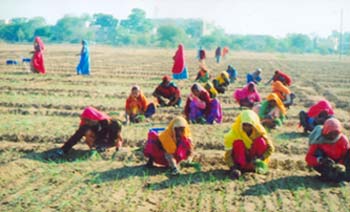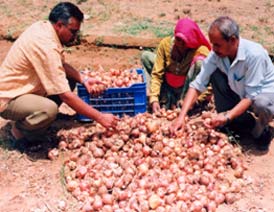Systematic research work for development of new varieties of various crops has contributed substantially to maximize agricultural production in the state. Augmentation in yield has been achieved not only by the breeding of basically higher yielding varieties, but also by the development of varieties that helps to stabilize production through resistance to diseases, pests and drought. Varieties are also bred for meeting specific agronomic requirements with wide adaptability. This research institute has developed and released
more than 125 varieties of different crops. Following is a brief varietal development scenario at this institute -
Wheat: Varieties developed-29
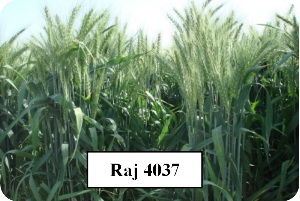
The triple dwarf variety 'Lal Bahadur' developed at Durgapura Center became the trendsetter towards developing high-yielding non-lodging, nutrient-responsive varieties. The variety Raj 1482 is very much in demand for its quality characteristics; Raj 3077, in addition to high yield, is well adopted for timely sown, late sown, and light to moderate saline/alkaline conditions; Raj 3765 & Raj 3777 have the tolerance to high temperature and rusts and are suitable for normal to very late sowing conditions, Raj 4037, Raj 4083 and Raj 4079 are highly heat-tolerant varieties for warmer areas, Raj Molya Rodhak-1 is a significant development to overcome the problem of Cereal Cyst Nematode (CCN). The development of Raj 4120 is an outstanding contribution of this institute, which has resistance to Ug 99 (stem rust), which is an emerging threat to wheat cultivation in India. Raj 4238 (IR-LS) was recently released and notified as having good yield potential and rust resistance. Two Varieties, Raj 4083 and Raj 4120, are bio-fortified, having high Fe and Zn Content (>40PPM).
Barley: Varieties developed- 31
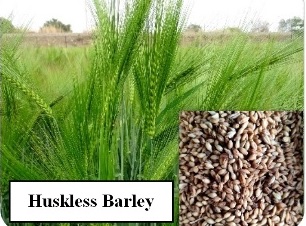
It is to the credit of this institute that the first dwarf mutant variety RDB-1 in the country was released from here and provided the genetic background for the development of dwarf varieties, a very important feature for barley crop. Other landmarks have been the salinity tolerant BL-2 and CCN resistant 'Rajkiran' along with other developed high-yielding varieties like RD 2035 and RD 2552 having wide adaptability and suitability for saline conditions, RD 2503 and RD 2668 (Two rowed type) for malting purpose. Varieties RD 2624 and RD 2660 developed for rainfed conditions are fabulous contributions of this institute. Recently, an excellent contribution of the institute is the development of the country's first dual-purpose barley variety RD 2715 having good potential to produce grain as well as green fodder. The new barley Varieties, RD 2786 (IRTS-FB), RD 2794 (Salinity tolerant), RD 2849 (Malt Barley), RD 2899 (IRTS-FB), and RD 2907 (Salinity tolerant), were released and notifiedas having good yield potential and rust-resistant. Currently, the development of huskless (naked) barley varieties is in progress and in near future huskless barley will be available to farmers.
Chickpea: Varieties developed- 18

The glorious achievement has been the first rainfedhigh-yielding variety RSG 888 and CSJ 515 at the National level and RSG-973 (Abha) at the State level. The variety CSJD-884 (Akash) is very much liked due to its double pod characteristic. Besides these, RSG-991 is the value-added variety having green seeds, RSG 963 preferable for late sowing,and CSJK 174 (early in maturity),CSJK 21 (Bold seeded) kabuli chickpea variety.
Mustard: Variety developed - 1
A very significant achievement has been the development of the Orobanche resistant variety 'Durgamani'.
Field Pea: Variety developed - 1
RPG-3 variety was released for grain purpose has high yield potential along with high protein content and resistance to powdery mildew.
Pearl Millet: Varieties developed - 13
 Bajra
Bajra is one of the important kharif cereals grown extensively in arid and semi-arid regions of the state. The area under the crop sometimes exceeds 45 lakh ha during the monsoon season. To center the need of the farmers high yielding composite namely Raj 171 and hybrids viz., RHB 90, RHB 121, RHB-127, RHB 173,RHB 177, RHB 223, and RHB 228 have been developed, which are resistant to downy mildew and have bristles on ear heads for protection from bird damage, suitable for cultivation in arid and semi-arid regions of the state. The hybrid RHB 154 has been developed for low rainfall (below 400 mm) areas of the Country (A1 Zone).Two biofortified (high iron and Zinc) dual purpose hybrid with high grain and dry fodder yield potential likely RHB 233 and RHB 234 for National level (A, A1 and A2 zone) have been developed.This hybrid will contribute to nutritional intervention programs as high-iron & zinc source food for reducing anemia and stunting in India.
Groundnut: Varieties developed - 8
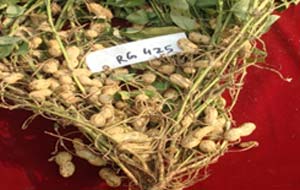
This center has developed high-yielding varieties like RG 425 - a semi-spreading drought tolerant and collar rot resistant; RG 382 - a large seeded spreading type; and RG 141 - a Spanish bunch type with moderate resistance to leaf spot, rust, collar rot, and bud necrosis. The high-yielding variety RG 638 (36.98 q/ha Pod Yield/ha) with tan colourtesta and good resistance to major diseases developed by this centre. Recently, the two high-yielding varieties, RG 648 and RG 575-1, were identified as having good resistance to major diseasesfor release.
Clusterbean: Varieties developed- 15
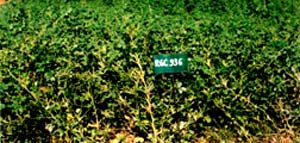
High yielding, photo-insensitive varieties, with high gum content have been developed. The significant work has been done for the development of high yielding, early and medium maturing varieties like RGC- 936, RGC-1002, RGC-1003, RGC-1017, RGC-1033, RGC-1038, RGC-1055, RGC-1066 (unbranched), Karan Guar 1 (RGr 12-1), Karan Guar 14 (RGr 18-1) and Karan Guar 15 (RGr 20-15)etc. These varieties are suitable for semi-arid conditions of the state
Cowpea: Varieties developed - 6
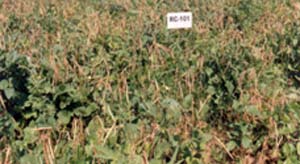
High yielding, early maturing varieties have been developed with fawn coloured grain (RC 19) as well as white grain (RC 101). Besides this, RCV-7 has been developed for vegetable purpose.
Mungbean: Varieties developed - 7
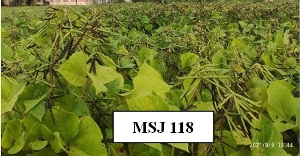
High-yielding and early maturing varieties like RMG 62, RMG 268, RMG 344, RMG 492 and RMG 975 with moderate tolerance to drought and web blight have been developed. Recently, the variety MSJ 118 has been developed with Khaki Colored seeds. This variety is popular among farmers because of the short duration (65 days) and the Khaki colour of the seed.
Muskmelon: Varieties developed - 5

Durgapura Madhu, known for its sweetness and fragrance has been a very popular variety with high public demand. Other varieties developed with high total soluble sugar and moderate resistance to root rot, powdery mildew and virus, are RM 50, MHY 3, MHY5, etc.
Watermelon: Varieties developed - 3
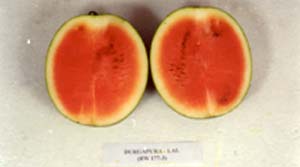
The variety 'Durgapura Kesar' (RW 187-2) with saffron coloured flesh has been a unique development from this institute. The other achievements are varieties with dark red flesh having high sweetness like 'Durgapura Lal' (RW 177-3).
Onion: Varieties developed - 3
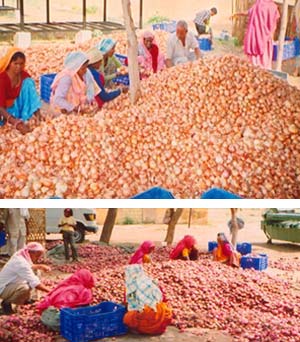
Onion is one of the most important commercial vegetable crops grown in Rajasthan. It occupies about 25 -30% area of the total vegetable crops in the state. It is predominantly a
rabi season crop but in
kharif season it accounts for about 10 -15% of the total production. The onion varieties RO-1 (copper red bulb, 2004) and RO-59 (red bulb, 2005) are the first released varieties of Rajasthan developed by this institute. Recently, RO-252 (red bulb, 2011) variety has also been developed and released for cultivation in Rajasthan. Both RO 59 and RO 252 were also found suitable for
kharif season.
